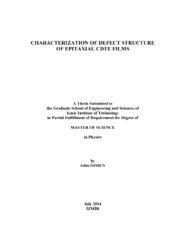Please use this identifier to cite or link to this item:
https://hdl.handle.net/11147/4224Full metadata record
| DC Field | Value | Language |
|---|---|---|
| dc.contributor.advisor | Selamet, Yusuf | - |
| dc.contributor.author | Özden, Selin | - |
| dc.date.accessioned | 2014-12-03T12:32:47Z | - |
| dc.date.available | 2014-12-03T12:32:47Z | - |
| dc.date.issued | 2014-07 | - |
| dc.identifier.uri | http://hdl.handle.net/11147/4224 | - |
| dc.description | Full text release delayed at author's request until 2015.08.07 | en_US |
| dc.description | Thesis (Master)--Izmir Institute of Technology, Physics, Izmir, 2014 | en_US |
| dc.description | Includes bibliographical references (leaves: 244-257) | en_US |
| dc.description | Text in English; Abstract: Turkish and English | en_US |
| dc.description.abstract | Mercury Cadmium Telluride (HgCdTe) is widely used material for infrared detection. Epitaxial growths carried on Gallium arsenide (GaAs) substrates gained more attention in recent years due to commercially availability of epi-ready wafers. However, large lattice mismatch between the HgCdTe epilayer and GaAs substrates, and Gallium (Ga) diffusion into HgCdTe layers during growth limit the device performance. In order to decrease large lattice mismatch and hereby dislocations formed at HgCdTe epilayer, a closely lattice matched Cadmium Telluride (CdTe) is preffered buffer layer for Molecular Beam Epitaxial (MBE) growth of HgCdTe. This thesis focuses on a study of defects on (211)B CdTe buffer layers grown on (211)B oriented GaAs substrates by MBE. Prior to epitaxial growth of CdTe layers, to understand the effect of wet cleaning procedure on chemical composition of epi-ready GaAs wafers, piranha solution-based wet chemical etching and oxide removal processes using diluted hydrofluoric acid (HF) were performed on undoped 625≤25 μm thick GaAs(211)B wafers. The surfaces of GaAs wafers were investigated by Atomic Force Microscopy (AFM) and Scanning Electron Microscopy (SEM). The variation of As2O3 and Ga2O3 contents on GaAs (211)B wafers studied by Raman spectroscopy. Following the growth of CdTe (211)B epitaxial films, the quality of CdTe layers were investigated in detail by various characterization techniques such as AFM, SEM, Nomarski Microscopy, X-ray Diffraction (XRD), Fourier Transform Infrared Spectroscopy (FTIR) and Raman Spectroscopy. Thicknesses of CdTe layers were calculated via intensity oscillations in the transmittance spectrum of the films. | en_US |
| dc.language.iso | en | en_US |
| dc.publisher | Izmir Institute of Technology | en_US |
| dc.rights | info:eu-repo/semantics/openAccess | en_US |
| dc.subject | Raman spectroscopy | en_US |
| dc.subject | Epitaxy | en_US |
| dc.subject | Epitaxial growth | en_US |
| dc.title | Characterization of Defect Structure of Epitaxial Cdte Films | en_US |
| dc.title.alternative | Epataksiyel Cdte Filmlerin Kusur Yapılarının Karakterizasyonu | en_US |
| dc.type | Master Thesis | en_US |
| dc.institutionauthor | Özden, Selin | - |
| dc.department | Thesis (Master)--İzmir Institute of Technology, Physics | en_US |
| dc.relation.publicationcategory | Tez | en_US |
| dc.identifier.wosquality | N/A | - |
| dc.identifier.scopusquality | N/A | - |
| item.openairecristype | http://purl.org/coar/resource_type/c_18cf | - |
| item.languageiso639-1 | en | - |
| item.openairetype | Master Thesis | - |
| item.grantfulltext | open | - |
| item.fulltext | With Fulltext | - |
| item.cerifentitytype | Publications | - |
| crisitem.author.dept | 01. Izmir Institute of Technology | - |
| Appears in Collections: | Master Degree / Yüksek Lisans Tezleri | |
Files in This Item:
| File | Description | Size | Format | |
|---|---|---|---|---|
| 10020938.pdf | MasterThesis | 25 MB | Adobe PDF |  View/Open |
CORE Recommender
Page view(s)
302
checked on Mar 31, 2025
Download(s)
186
checked on Mar 31, 2025
Google ScholarTM
Check
Items in GCRIS Repository are protected by copyright, with all rights reserved, unless otherwise indicated.